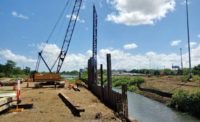The fact that floodwalls around New Orleans were designed to be overtopped but remain standing says much about the post-Katrina hurricane-protection system that rings the city—and about the risks that those who live within that system still face.
The U.S. Army Corps of Engineers and other experts don’t hesitate to affirm that the Corps's $14.6-billion system designed to protect New Orleans is bigger, better and stronger than the flood barriers that failed when Katrina hit in 2005.
The system, says University of Maryland engineering professor Gerry Galloway, is a magnificent engineering feat.
“Does that mean that there won’t be a lot of water in the city at some point?” Galloway asks. “No.”
The 10th anniversary of the storm's Aug. 29 Gulf Coast landfall has made people in metropolitan New Orleans more aware that the system, built to protect the city from a so-called 100-year storm, is primarily a standard that allows the city to be covered by the National Flood Insurance Program.
“The thing that concerns many, and perhaps even some at the Corps: We are still stuck on the idea [that] 100-year storm frequency is somehow related to a safety standard,” says Bob Turner, regional director at Southeast Louisiana Flood Protection Authority-East, which operates and maintains levees in Orleans Parish, East Jefferson Parish and St. Bernard Parish. “People look at [that standard], and perhaps they might become complacent and might not be taking measures that they should be taking.”
While there is some hope that the system will be built to a higher standard—Louisiana’s master coastal plan calls for a 500-year system—the state and its citizens are looking at other means to improve the region’s chances for survival. These include a $50-billion plan to protect and rebuild the wetlands and barrier islands that help protect the coast from storm surge.
“You have to get a comprehensive portfolio of how to reduce risk,” says Galloway, a former Corps district engineer. “Your immediate reaction can no longer be ‘build me something.’”
Don't Overlook the 1%
After Katrina, Congress approved and appropriated billions to the Corps to rebuild a Hurricane and Storm Damage Risk Reduction System to a 100-year-storm standard, a weather event that has a 1% probability of occurring each year.
That standard, while technically lower than the “standard project hurricane” design that was in place before the storm, has provided for a much heartier system than the previous one, which was “piecemeal” and a “system in name only,” according to Mike Park, chief of operations for the Corps district in New Orleans.
Between 2006 and 2011, the agency oversaw the rebuilding or construction of 350 miles of levees and floodwalls, 73 pumping stations, three canal-closure structures and four gated outlets.
The floodwalls, arguably the weakest link in the pre-Katrina system, were built 3 ft higher than called for to meet today’s flood standard. And they are built to remain standing if water overtops the walls.
All told, the perimeter of the area that can be directly exposed to storm surge is 70 miles shorter than it was before Katrina, Park says.











